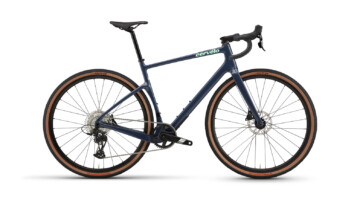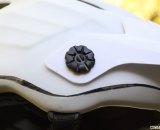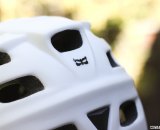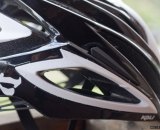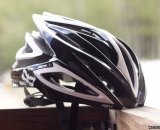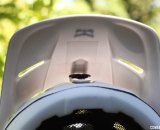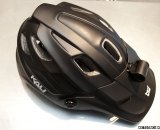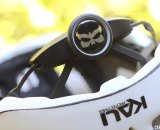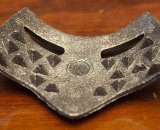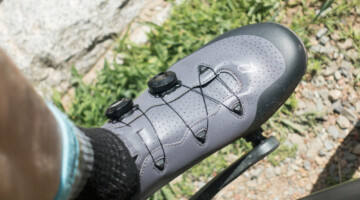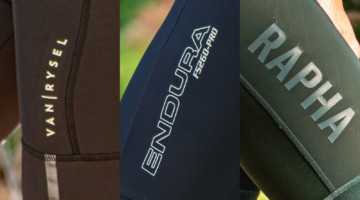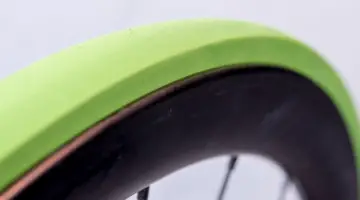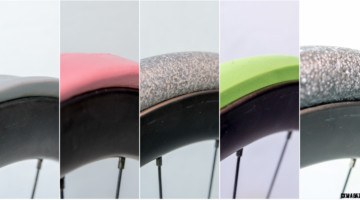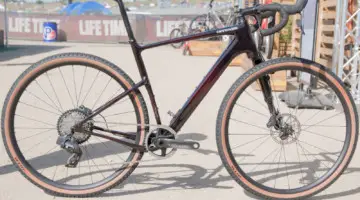
Kali Protectives Maya helmets, designed with mountain bikers and urban commuters in mind. © Cyclocross Magazine
When we last spoke with Kali Protectives Founder Brad Waldron last February at Winter Press Camp, he saw a concern with the direction helmets are headed: cyclists, especially roadies, want more, larger vents, which translates to needing highly dense foam to fill in the remaining gaps.

Brad Waldron shows off the protective design of Cone-head technology, putting the emphasis on safety above all else. © Cyclocross Magazine
The large ventilated Maraka and Phenom are two of the company’s highest price point helmets for cross country and road, respectively, which use less dense foam and reinforce the vents so the helmets can can react to impacts big and small. The company meets the desires of the cycling audiences, but not at the expense of their safety standards, which well surpasses the minimum requirements for standards in the United States.
Maya

The Maya bike helmet comes with an array of mounts for lights and GoPro cameras. © Cyclocross Magazine
We have been riding with one of Kali Protective’s upcoming models, the Maya. Aimed to be affordable lightweight protection for the urban and mountain bike crowd, the Maya will enter the race at the price point of $100, more than a basic urban helmet, but much less than half of the lightest and most ventilated entries in the market.
Its visor is likely one of the largest you’ll ever see on a cyclocross course, which lends us to believe that the Maya is geared for the mountain bike audience who spends hours in the saddle during endurance rides, but it certainly will do its job of keeping some rain and mud splatter off your eyewear. Nighttime riders and adrenaline junkies alike will enjoy the plentiful option mounts on the helmet visor that can be used for attaching lights and GoPro cameras.
For the limited time we have tested the Kali Protectives Maya helmet, we’ve enjoyed the adjustability of the visor along with the sizing dial on the helmet’s retention system, which is also adjustable for height. In terms of fit, the ample pads and built-in bug netting on the inside of the Maya helps provide a great fit, eliminating the hotspots and cradling the head in the same go.
One might notice a lack of vents on the helmet’s sides, and while the Maya isn’t exactly an ALS ice bucket to your head, since most ventilation happens by moving air over your head when moving forward, the lack of side vents isn’t a deal breaker if you’re not an observed trials rider and actually enjoy pedaling your bike forward.
The only problem with the mesh liner is that it keeps your sweaty hair matted down against the scalp, which unfortunately becomes a good insulator on those toasty summer days. Those of you with buzzed or shaved heads won’t mind this; the lacks of side vents doesn’t heat up a head nearly as much as the mesh.

The supportive mesh keeps your hair from poking through the vents, but it also keeps it mashed against your scalp. © Cyclocross Magazine
We currently are testing a pre-production model that weighs in a 325 grams as a medium size, so the fit and finish of the white and black models isn’t necessarily the final product.
Phenom
As mentioned earlier, Kali Protective’s Phenom, available at retail stores now, uses reinforcements around their large vents, called Supervent technology, in order to dissipate the force of a major impact. We’ve seen this same technology on the Editors’ Award-winning Maraka helmet.
The Phenom looks the part of a high-end helmet with a countless array of vents and a claimed weight of 300 grams. The helmet even features a trailing edge that comes to a point, which the Kali team admits serves more of a road-oriented look than a safety-enhancing feature. Considering the ventilation and weight, the Phenom might surprise potential buyer with a price tag of $160.

Each supervent comes with a reinforced edge, creating more weight but a safer helmet. © Cyclocross Magazine
Better still, the helmet is designed for riders who are happy to place the premium on safety, especially if their concept of safety means exceeding most regulatory standards of the U.S. market. Below is a picture of Kali’s Cone-head technology, which further dissipates the force of impact by redirecting it away from vulnerable targets.
Nanotech: Ending Disposable Helmets?
In their constant pursuit of the most advanced technology in helmet safety, the team has been working with a “Nanotech” material that is said to offer an ability to absorb and recover from multiple impacts. While modern EPS helmets are designed to crush upon impact, absorbing the energy and shock once but then rendered useless, Nanotech promises to at the very least offer head protection while you ride to the finish line or home after a crash. Perhaps the first application could be for snow sports, where crashes are arguably more commonplace, or park-oriented cycling and skate helmets.
Check out the demonstration of the difference between a standard helmet (first) and Nanotech (second):
[youtube EHtI7IHYnNE 590 400]
However, any experienced cyclocrosser knows all the variables in cyclocross are sometimes a recipe for multiple crashes per lap, and thus such technology could really hit home.
More info: kaliprotectives.com
- The Maya’s visor accepts optional light and camera mount. © Cyclocross Magazine
- Screw on, not snap-on. © Cyclocross Magazine
- Kali Protectives’ Maya bike helmet has ample rear vents. © Cyclocross Magazine
- Each supervent comes with a reinforced edge, creating more weight but a safer helmet. © Cyclocross Magazine
- Kali Protectives Phenom, designed for the road. © Cyclocross Magazine
- The supportive mesh keeps the bugs out and your hair from poking through the vents sweaty matted hair adds to the warmth. © Cyclocross Magazine
- The visor is large enough to keep the sun at bay. © Cyclocross Magazine
- The Maya bike helmet comes with an array of mounts for lights and GoPro cameras. © Cyclocross Magazine
- Brad Waldron shows off the protective design of Cone-head technology, putting the emphasis on safety above all else. © Cyclocross Magazine
- Kali Protectives Maya helmets, designed with mountain bikers and urban commuters in mind. © Cyclocross Magazine
- The Cone-head technology redirects impacts instead of just absorbing them. © Cyclocross Magazine
- Rounder is safer according to Kali. © Cyclocross Magazine
- Kali Protectives Maya bike helmet lets you dial-in the fit. © Cyclocross Magazine
- Kali Protectives Maya bike helmet lets you dial-in the fit. © Cyclocross Magazine
- The mesh liner keeps the bugs out, eliminates “hot spots” but keeps hair down. © Cyclocross Magazine
- Kali Protectives is always looking for safety innovations including these shock-absorbing pyramids. © Cyclocross Magazine
- Customized fit is possible with the dial and height-adjustment. © Cyclocross Magazine
- Generous amount of padding, and a built-in bug netting. © Cyclocross Magazine

